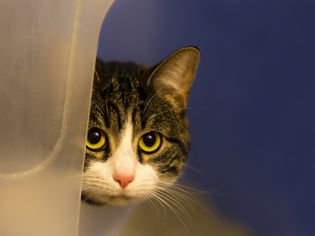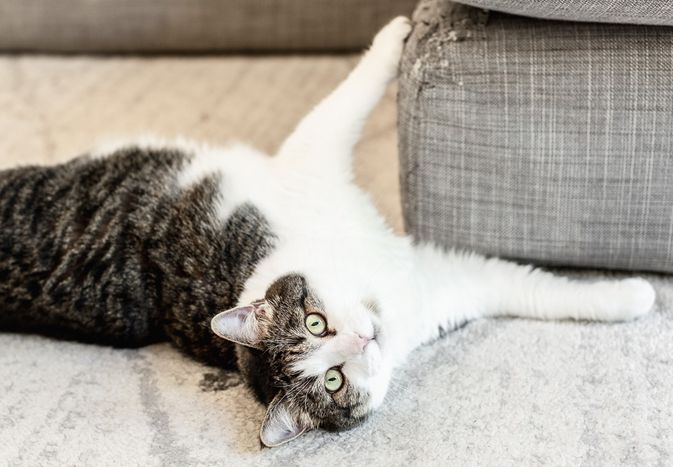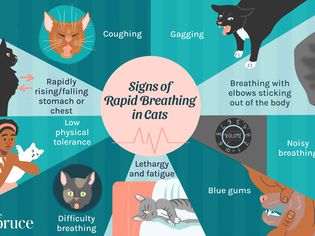Fear aggression is the most common type of feline aggression. A percentage of cats simply inherit the "shy gene" and act aggressively every time they become frightened. Poor socialization also results in fear aggression. Punishment by the owner can make it worse. Cats may develop "stranger danger" fear of people, places, other cats, certain noises, or even odors, and react with aggression. They can generalize one scary experience (such as a car ride to the vet) with all future car rides. A single "bad" episode with a longtime feline friend can turn the relationship sour and prompt inter-cat aggression.
Recognizing Cat Fear Aggression
In order to train your fearful cat to not be aggressive, you need to be able to recognize their triggers. Scared cats quickly learn that aggressive behavior makes the scary "thing" go away. Once this behavior is learned, they will use it repeatedly to ward off the trigger. Affected cats may turn from offense to defense and back again during the arousal. They display a mix of defensive body signals (ears flattened sideways, tail tucked, crouching, and leaning away) and aggressive signals (fluffed fur, showing teeth, hissing, growling, swatting, biting, and scratching). Usually, the pupils of their eyes dilate wide with no relation to the amount of light present.
If you can determine the trigger, you will have a much easier time soothing the cat and helping to eliminate the fear aggression in cats. If the cat's fear aggression is mild and you can avoid the triggers that make your kitty aggress, no other treatment may be necessary. If that's not the case and the triggers either can't be avoided or identified, you'll need to work to diffuse the fear.
Check With a Vet
Your first step should be to schedule a vet visit for a checkup. Sometimes aggressive behavior can indicate a medical condition in the cat, even if it doesn't seem sick. This is especially true if the cat is displaying a sudden behavioral change. If your cat hasn't been spayed or neutered, this is something you might consider. The physical change could impact their behavior (by becoming less aggressive) but should be discussed with a vet prior to any decisions.
Understand the Triggers
If your cat has been cleared of any medical issues, it's important to figure out the cat's tolerance levels and reactive distance. For instance, your kitty may be fine as long as the trigger stays six feet away, but reacts with fear at five feet. Avoid situations by maintaining an appropriate distance between the fearful cat and potential triggers. Then slowly work up to reducing the distance or gently increasing the time spent with the trigger, showing the cat that there is no reason to be fearful. How you ease into the trigger can depend on what the exact trigger is. Speak with your vet to help with suggestions, especially if the cat's trigger is something that absolutely cannot be avoided.
Create Safe Spaces
Increase the numbers of quiet areas and hiding spots available to your cat in the home. Elevated perches such as shelf space and small boxes to hide make cats feel more secure. Create a house of plenty by providing lots of toys, scratching posts, and litter boxes (at least one per cat plus one) to reduce competition with other cats.
Ease Stress
Visual contact heightens cat arousal and can increase aggressive episodes or make them worse. If another cat is causing stress, separate the cats with solid doors to calm the angst. Use Feliway or a similar cat pheromone product to ease stress in the cat's territory. Rescue Remedy or other flower essences can help shy and fearful pets, so add several drops to their water.
Focus on Play and Training
Use interactive play to build feline confidence. A fishing pole toy or the beam of a light pointer allows the cat to have fun with you but from a distance, which is not likely to trigger an attack. Training cats to do tricks builds confidence and helps improve the bond you share. You can use clicker training to communicate with your cat and show approval. When the cat's fear aggression focuses on another cat, use positive reinforcement and counter-conditioning techniques to reduce the cat-on-cat aggression.
Problems and Proofing Behavior
A common mistake is to expect fear aggression to be eliminated immediately. If you can recognize the trigger, it will still take time, practice, and consistency to help your cat eliminate the fear aggression. Don't be surprised if they have relapses and don't scold your cat, as that will only make it worse. If the fear aggression cannot be eliminated or you are having a particularly tough time identifying the trigger, it may be time for professional help. A vet or seasoned feline behavior specialist will be able to assist you and your cat.










Comments on " How to Train Your Cat to Eliminate Fear Aggression" :